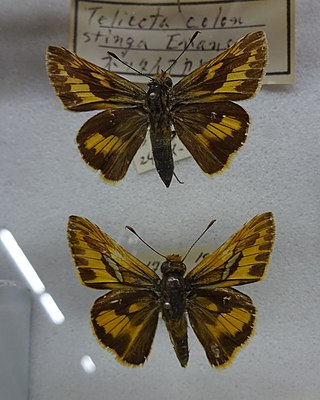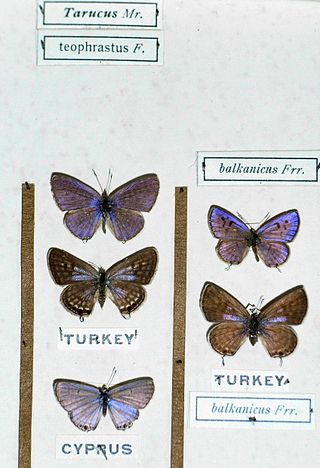
Apamea monoglypha, the dark arches, is a moth of the family Noctuidae. The species was first described by Johann Siegfried Hufnagel in 1766. It is a common, sometimes abundant, European species. It is found in most of Europe except northernmost Fennoscandia and the southern parts of the Iberian Peninsula and Greece. The species is also found in Anatolia, Turkestan, Western Asia and Central Asia, Siberia and Mongolia. In the Alps it is found up to heights of 2,500 meters. The smaller subspecies sardoa is found on Sardinia and Corsica.

Apamea crenata, known as the clouded-bordered brindle, is a moth in the family Noctuidae. It is distributed throughout the Palearctic realm. In the North it crosses the Arctic Circle, in the Mediterranean it is found only in cool locations and mountains avoiding very hot areas. In the Alps, it rises to an altitude of about 2000 metres.

Telicota colon, commonly known as the pale palm dart or common palm dart, is a butterfly belonging to the family Hesperiidae found in India to Australia.

Athyma selenophora, the staff sergeant, is a species of nymphalid butterfly found in tropical and subtropical Asia.

Miletus symethus, the great brownie, is a small butterfly found in India that belongs to the lycaenids or blues family. The species was first described by Pieter Cramer in 1777.

Logania distanti, the dark mottle, is a small but striking butterfly found in India that belongs to the lycaenids or blues. It was first described by Georg Semper in 1889.

Tarucus theophrastus, the common tiger blue, pointed Pierrot or African Pierrot, is a small butterfly found in the Old World tropics. It belongs to the lycaenids or blues family.

Curetis bulis, the bright sunbeam, is a species of butterfly belonging to the lycaenid family. It is found in Asia.
Catalexis is a genus of moths in the family Gelechiidae. It contains the species Catalexis tapinota, which is found in Guatemala.

Grammodes stolida, the geometrician, is a moth of the family Erebidae. The species was first described by Johan Christian Fabricius in 1775. It is found in Africa, southern Europe, most of Asia and Australia. It migrates to central and northern Europe as far north as England, Denmark and Finland.
Aroga elaboratella is a moth of the family Gelechiidae. It is found in North America, where it has been recorded from California and Baja California.
Recurvaria sticta is a moth of the family Gelechiidae. It is found in Mexico (Guerrero).
Gelechia petraea is a moth of the family Gelechiidae. It is found in Guatemala.
Battaristis symphora is a moth of the family Gelechiidae. It was described by Walsingham in 1911. It is found in Mexico (Tabasco).
Compsolechia zebrina is a moth of the family Gelechiidae. It was described by Walsingham in 1910. It is found in Mexico (Tabasco).
Stomopteryx deverrae is a moth of the family Gelechiidae. It was described by Walsingham in 1905. It is found in Algeria and Spain.
Aristotelia squamigera is a moth of the family Gelechiidae. It was described by Walsingham in 1909. It is found in Mexico (Guerrero).
Psittacastis stigmaphylli is a moth in the family Depressariidae. It was described by Lord Walsingham in 1912. It is found on Jamaica.
Antaeotricha comosa is a moth in the family Depressariidae. It was described by Lord Walsingham in 1912. It is found in Mexico.
Stenoma ferrocanella is a moth in the family Depressariidae. It was described by Francis Walker in 1864. It is found in Panama and Brazil (Amazonas).








